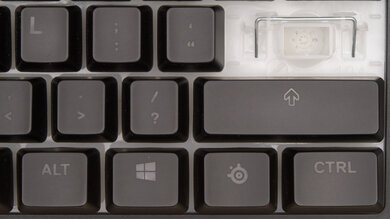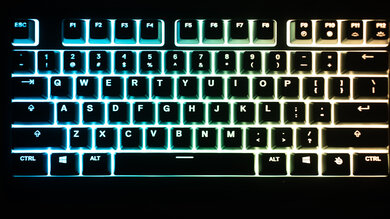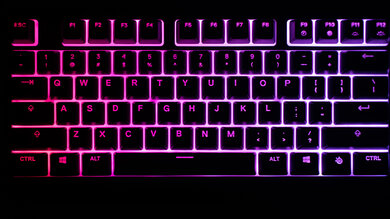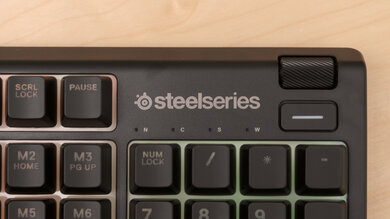The SteelSeries Apex 3 is a good gaming keyboard with rubber dome switches. It has a good build quality despite its budget price, and it also comes with a nice magnetic wrist rest. It provides a decent typing experience that isn't fatiguing, but some people might find the keys slightly mushy and that they lack distinct tactile feedback. Unfortunately, its latency is a bit high for a wired keyboard, and its rubber dome switches have a long pre-travel distance, so it's not the most responsive. The RGB backlight is zone-lit, although there's still a decent number of customization options through SteelSeries' Engine software. Overall, it's a good option for those on a budget or just don't like mechanical keyboards.
Our Verdict
The SteelSeries Apex 3 is a good gaming keyboard. However, even though the keys are relatively easy to actuate, the rubber dome switches have a long pre-travel distance, and the keyboard's latency is fairly high, making it feel a bit unresponsive. You can set macros to any key, but it doesn't have dedicated macro keys for MMO players. Additionally, the RGB backlight is zone-lit, so you won't be able to customize each key individually.
- Good build quality.
- Great software support.
- Decent typing experience.
- High latency for a wired keyboard.
- Zone-lit backlighting.
The SteelSeries Apex 3 is a good office keyboard. The rubber dome switches offer a decent typing experience, though some may find it a bit mushy. Typing noise is minimal, so it shouldn't bother your surrounding colleagues, even in the most noise-sensitive environments. Build quality is good and shouldn't cause any issues in the long run, and it's compatible with all desktop operating systems, though some keys don't work on macOS.
- Good build quality.
- Great software support.
- Decent typing experience.
- Keys feel a bit mushy and lack distinct tactile feedback.
The SteelSeries Apex 3 is a wired-only keyboard and can't be used with mobile devices.
The SteelSeries Apex 3 is a decent keyboard for programming. Every key is macro-programmable, although it's limited to Windows and macOS users only because its customization software isn't available for Linux, and there's no onboard memory. Typing on it feels decent, but some people may find the rubber dome switches a bit mushy, and the tactile feedback isn't as obvious.
- Good build quality.
- Great software support.
- Decent typing experience.
- Zone-lit backlighting.
- Wired-only.
- Keys feel a bit mushy and lack distinct tactile feedback.
The SteelSeries Apex 3 is bad for use with a home theater PC. You can only use it wired, so you need to run a cable from the couch to the computer, which isn't ideal if you have kids or pets. Also, it lacks a trackpad, so you'll need a separate mouse to navigate. It has backlighting for those who like to watch TV in the dark, but the keys aren't individually-lit.
- Great software support.
- Decent typing experience.
- No trackpad.
- Zone-lit backlighting.
- Wired-only.
- Great software support.
- Decent typing experience.
Changelog
- Updated Nov 29, 2023: We've converted this review to Test Bench 1.3.1, which adds a new estimated PCB latency test to the Single-Key Latency section and a new Analog test to the Switches section of this review. You can see the full changelog here.
- Updated Oct 27, 2023: We've converted this review to Test Bench 1.3, which overhauls how key input is evaluated. We've added new tests for Single Key Latency, Multi Key Latency, Data Transmission, and Chord Split. We've also introduced a new Raw Performance usage and adjusted how the Gaming and Office usage scores are calculated. You can see the full changelog here.
- Updated Jun 15, 2023: We've converted this review to Test Bench 1.2. This update introduces new Backlight Features and Backlight Clarity test boxes. We've also added a new Switches test box, added additional test comparisons to our Hardware Customizability test box that we introduced with our last Test Bench. For an in-depth look at our changes, you can see our full changelog here.
- Updated May 19, 2023: We've converted this review to Test Bench 1.1. This update adds several new tests addressing Hardware Customization, Macro Keys And Programming, and Wireless Mobile Compatibility. We've also added new objective evaluations to the Typing Noise test, and we've simplified several tests and removed several others that were no longer relevant. For an in-depth look at all our changes, you can see our full changelog here.
Check Price
Differences Between Sizes And Variants
We tested the SteelSeries Apex 3 in black, which is the only variant in this size. There's a TenKeyLess variant, the SteelSeries Apex 3 TKL, and there are many keyboards with various configurations in the Apex lineup, like the SteelSeries Apex 5, the Apex 7 TKL, and the Apex Pro.
Popular Keyboard Comparisons
Since the SteelSeries Apex 3 is a membrane keyboard, it can be difficult to compare it to mechanical gaming keyboards, as the latter are much more responsive due to their shorter pre-travel distance. However, compared to a similar keyboard such as the Razer Cynosa Chroma, the SteelSeries has a much better typing experience, though the Razer has a more customizable RGB backlight, as it's individually lit. For other options, check out our recommendations for the best keyboards for writers, the best RGB keyboards, and the best gaming keyboards.
The SteelSeries Apex 5 and the SteelSeries Apex 3 are very different despite being from the same lineup. In terms of gaming performance, the Apex 5's hybrid mechanical switches have a shorter pre-travel distance and a slightly lower operating force than the rubber dome switches on the Apex 3, making them more responsive and easier to actuate. However, the Apex 5's latency is much higher than the Apex 3's and likely a dealbreaker for some. Other than that, the Apex 5 has an OLED screen, individually-lit RGB backlighting, and onboard memory, all features that the Apex 3 lacks.
The SteelSeries Apex 3 and the Corsair K55 RGB are both full-sized gaming keyboards with rubber dome switches. The SteelSeries has a sturdier-feeling build quality and keystrokes that require less operating force. The Corsair has substantially lower latency, and though its keystrokes require a higher operating force, they also have better tactile feedback, although that can tire your fingers more quickly.
The SteelSeries Apex 3 is essentially a bigger version of the SteelSeries Apex 3 TKL, but there are a few differences. The Apex 3 has a numpad, and it comes with a wrist rest for better ergonomics. However, typing feels the same on each because they use the same rubber dome switches. They each have zone-lit RGB lighting, but the Apex 3 has ten customizable zones due to its bigger size compared to the TKL's eight zones. The TKL version uses the new SteelSeries GG software, which includes the Engine software that the Apex 3 uses. Other than that, both keyboards are very similar.
For most uses, the SteelSeries Apex 3 is significantly better than the Logitech G213 Prodigy. The SteelSeries' build quality is much better, it has full RGB backlighting with brightness control, and every key is macro-programmable. The SteelSeries also provides a better typing experience, it produces less typing noise, and the included wrist rest is detachable if you don't want to use it.
Test Results

Build quality is good. It has a fully plastic frame that exhibits a decent amount of flex, and the keycaps are made of ABS plastic with a soft finish. The overall build quality feels slightly worse than the rest of the Apex lineup. SteelSeries advertises this keyboard as having an IP32 water and dust resistance, though this isn't something we test for.
The SteelSeries Apex 3 has a 10-zone RGB backlighting. It can be customized through SteelSeries' Engine software, and you can control the brightness directly on the keyboard. There are a few lighting presets that you can choose from, as well as a rainbow effect that doesn't show where each zone starts and ends. If you want individually-lit keys, check out the SteelSeries Apex 5.
The cable is rubberized and it's not detachable.
This is a wired-only keyboard.
The SteelSeries Apex 3 has dedicated media controls. The button located below the volume wheel lets you play, pause, skip tracks or go to the previous track. There are hotkeys that allow you to control the brightness of the backlight, set macros, and change your profile. You can also lock the Windows key to prevent accidentally minimizing your game by pressing the SteelSeries key and the Windows key at the same time.
The typing experience is decent. The keys are very stable and don't wobble at all, but they do feel a bit mushy, and it can be difficult to tell if a keypress was registered at times because the tactile feedback is not as obvious. The wrist rest helps a lot in preventing fatigue. It's a better typing experience than on other membrane keyboards like the Razer Cynosa Chroma. If you prefer the feel of mechanical switches while typing, then look into the NPET K20.
Typing noise is very quiet, making this keyboard suitable for quiet office environments.
The SteelSeries Apex 3 uses rubber dome switches. They have a fairly high pre-travel distance, which can lead to better typing accuracy, as there's less of a chance for unintended keystrokes to be registered. It requires a moderate amount of force to get over the tactile bump, but not to the point that we would consider them heavy. If you want a mechanical keyboard that's affordable like the Apex 3, check out the AUKEY KM-G9 or the Redragon K552 KUMARA RGB.
The SteelSeries Apex 3's latency is decent, a bit high for a wired keyboard. It should be fine for most people, but it might not be good enough for competitive gamers. If you want a non-mechanical board with lower latency, check out the ROCCAT Magma. If you want an exceptionally low latency and don't mind a mechanical board, check out the EVGA Z20.
The SteelSeries Engine software is good. It lets you customize the backlight, set macros, and save profiles. The keyboard doesn't have onboard memory, which makes it harder to switch to another computer. There's a cloud sync option, though it requires an account. If you're interested in a keyboard with onboard memory for settings, check out the Corsair K55 RGB PRO XT.
The SteelSeries Apex 3 has decent compatibility. It works fully on Windows, but Scroll Lock and Pause/Break don't work on macOS. All keys function properly on Linux, but since there's no software for that platform and there's no onboard memory, Linux users won't be able to customize the keyboard.











